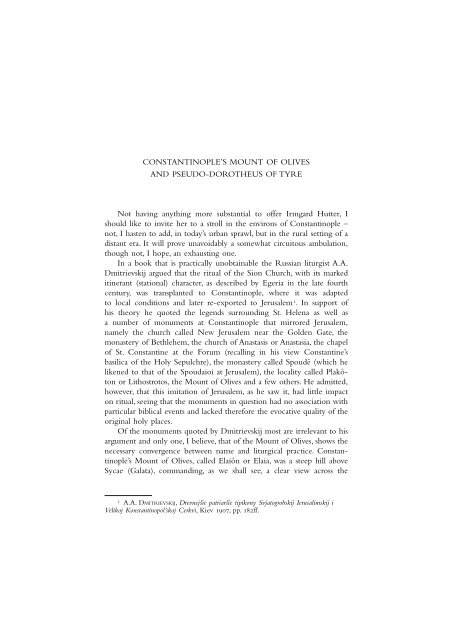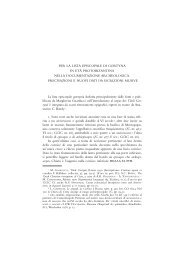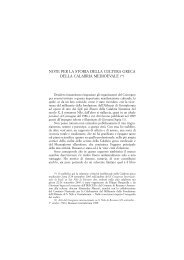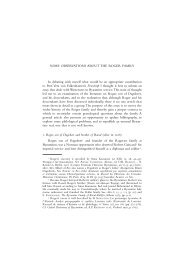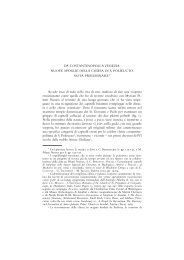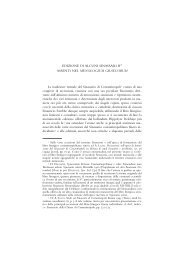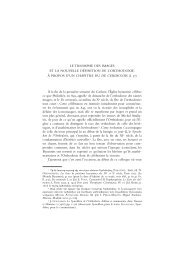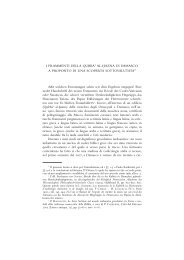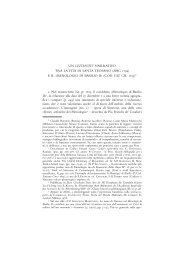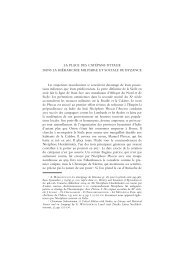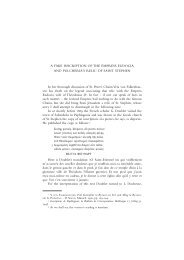CONSTANTINOPLE'S MOUNT OF OLIVES AND PSEUDO ...
CONSTANTINOPLE'S MOUNT OF OLIVES AND PSEUDO ...
CONSTANTINOPLE'S MOUNT OF OLIVES AND PSEUDO ...
You also want an ePaper? Increase the reach of your titles
YUMPU automatically turns print PDFs into web optimized ePapers that Google loves.
CONSTANTINOPLE’S <strong>MOUNT</strong> <strong>OF</strong> <strong>OLIVES</strong><br />
<strong>AND</strong> <strong>PSEUDO</strong>-DOROTHEUS <strong>OF</strong> TYRE<br />
Not having anything more substantial to offer Irmgard Hutter, I<br />
should like to invite her to a stroll in the environs of Constantinople –<br />
not, I hasten to add, in today’s urban sprawl, but in the rural setting of a<br />
distant era. It will prove unavoidably a somewhat circuitous ambulation,<br />
though not, I hope, an exhausting one.<br />
In a book that is practically unobtainable the Russian liturgist A.A.<br />
Dmitrievskij argued that the ritual of the Sion Church, with its marked<br />
itinerant (stational) character, as described by Egeria in the late fourth<br />
century, was transplanted to Constantinople, where it was adapted<br />
to local conditions and later re-exported to Jerusalem 1 . In support of<br />
his theory he quoted the legends surrounding St. Helena as well as<br />
a number of monuments at Constantinople that mirrored Jerusalem,<br />
namely the church called New Jerusalem near the Golden Gate, the<br />
monastery of Bethlehem, the church of Anastasis or Anastasia, the chapel<br />
of St. Constantine at the Forum (recalling in his view Constantine’s<br />
basilica of the Holy Sepulchre), the monastery called Spoudê (which he<br />
likened to that of the Spoudaioi at Jerusalem), the locality called Plakôton<br />
or Lithostrotos, the Mount of Olives and a few others. He admitted,<br />
however, that this imitation of Jerusalem, as he saw it, had little impact<br />
on ritual, seeing that the monuments in question had no association with<br />
particular biblical events and lacked therefore the evocative quality of the<br />
original holy places.<br />
Of the monuments quoted by Dmitrievskij most are irrelevant to his<br />
argument and only one, I believe, that of the Mount of Olives, shows the<br />
necessary convergence between name and liturgical practice. Constantinople’s<br />
Mount of Olives, called Elaiôn or Elaia, was a steep hill above<br />
Sycae (Galata), commanding, as we shall see, a clear view across the<br />
1 A.A. DMITRIEVSKIJ, Drevnejˇsie patriarˇsie tipikony Svjatogrobskij Ierusalimskij i<br />
Velikoj Konstantinopol’skoj Cerkvi, Kiev 1907, pp.182ff.<br />
157
158<br />
CYRIL MANGO<br />
Bosphorus. It probably corresponds roughly to today’s Cihangir (fig. 1).<br />
Its best known landmark was the leperhouse of St. Zoticus, whose site<br />
may be marked by a large cistern (internal dimensions 35.20 by 31.10<br />
m.), originally containing 42 columns, found in 1939 in that vicinity,<br />
along Siraselviler Caddesi, south of the German hospital. It must have<br />
served an important establishment. Hence Mamboury may have been<br />
right in connecting it with the hospital of St. Zoticus 2 .<br />
Our next stop will take us on a lengthy, but necessary detour leading<br />
to the tangled question of how and when the church of Constantinople<br />
came to fabricate for itself an apostolic origin.We may note that<br />
some such claim was already being made by AD 600, not only in hagiographic<br />
texts 3 , but also in official documents 4 .<br />
The choice of apostle posed no difficulty: it had to be Andrew.<br />
Already Eusebius, quoting Origen, tells us that Andrew was said to have<br />
evangelized Scythia, i.e. the north coast of the Black Sea 5 . If he reached<br />
Scythia, it was reasonable to suppose that either on his outward or his<br />
return journey he would have passed by way of Byzantium.The original<br />
Acta Andreae (third century?) is lost, but in the Latin summary by Gregory<br />
of Tours Andrew does stop at Byzantium.What he did there we are<br />
not told 6 . In the Index discipulorum by pseudo-Epiphanius of uncertain<br />
date 7 we find in twentieth place among the Seventy Disciples Stachys,<br />
«appointed first bishop of Byzantium by the apostle Andrew at Argyropolis<br />
of Thrace» 8 (Turkish Tophane outside Galata) (fig. 1). Stachys is<br />
2 H. MAMBOURY, Les fouilles byzantines à Istanbul, in Byzantion 21 (1951), pp.<br />
430-431.<br />
3 La Vie ancienne de S. Syméon Stylite le Jeune, ed. P. VAN DEN VEN, Bruxelles 1962<br />
(Subsidia hagiographica, 32), § 202.11: τ πστλικ θρνω τς ασιλευσης πλεως.<br />
Cf. Vie de Théodore de Sykéôn, ed. A.-J. FESTUGIÈRE, I, Bruxelles 1970 (Subsidia hagiographica,<br />
48), § 136.11.<br />
4 HERACLIUS, Nov. 2, a.617, ed. J. KONIDARIS, Die Novellen des Kaisers Herakleios,<br />
Frankfurt a. Main 1982 (Fontes minores, 5), p. 72: τ τν πστλικν τατης διέπντς<br />
θρνν.<br />
5 Hist. eccl., 3.1.1-3.<br />
6 Acta Andreae, ed. J.-M. PRIEUR, Turnholti 1989 (Corpus Christianorum. Series<br />
apocryphorum, 6), p. 587.<br />
7 F. DVORNIK, The Idea of Apostolicity in Byzantium and the Legend of the Apostle<br />
Andrew, Cambridge Mass. 1958, p.175ff. wishes to date pseudo-Epiphanius to the<br />
end of the seventh or beginning of the eighth century because the Index was not<br />
used by the author of the Chronicon Paschale, but that is hardly conclusive.<br />
8 Prophetarum vitae fabulosae, ed. Th. SCHERMANN, Leipzig 1907, p.120. Cf. Latin<br />
version by Moses of Bergamo, ed. F. DOLBEAU, Une liste ancienne d’apôtres et de disciples,<br />
in Analecta Bollandiana 104 (1986), p. 311,No.XXIII.
COSTANTINOPLE’S <strong>MOUNT</strong> <strong>OF</strong> <strong>OLIVES</strong> <strong>AND</strong> <strong>PSEUDO</strong>-DOROTHEUS <strong>OF</strong> TYRE 159<br />
Fig. 1. Plan of Constantinople adapted from The Oxford History of Byzantium, ed.<br />
C. MANGO, Oxford 2002, p.64.
160<br />
CYRIL MANGO<br />
mentioned in the Epistle to the Romans (16.9) where St. Paul sends him<br />
greetings. Rome being the official name of Constantinople, his choice<br />
was not entirely arbitrary.<br />
A much fuller story purports to be the work, or rather the summary<br />
of a work by a certain Dorotheus bishop of Tyre. This personage is presented<br />
as a victim of the Great Persecution. Having escaped to Odyssopolis,<br />
i.e. Odessus (Varna) of all places, he later returned to Tyre and<br />
took part in the Council of Nicaea. He was again persecuted under<br />
Julian the Apostate, fled for a second time to Odyssopolis and died there<br />
at the age of 107 after suffering torture. Learned in both Greek and<br />
Latin, he composed many works on ecclesiastical matters. Whether<br />
Dorotheus is completely fictional or conceals a historical person has<br />
never been determined, nor is it clear how he came to be commemorated<br />
in the liturgical calendar 9 . We may note, however, that he is the<br />
subject of two separate notices in the Chronicle of Theophanes (AD<br />
813), first under AM 5816 (twentieth year of Constantine) and again<br />
under 5854 (second year of Julian).The first notice 10 is introduced by the<br />
familiar formula «there flourished at that time» (ττε κµαεν) characteristic<br />
of chronicles of the Eusebian type, and contains the statement, «He<br />
wrote an accurate account of the bishops of Byzantium and many other<br />
places». It goes on to say that after returning from his first exile (we are<br />
not told where) at the time of Diocletian, he attended the Council (of<br />
Nicaea) and regained his own see, but, on account of Julian’s persecution,<br />
was forced to flee again (πάλιν) to Odyssopolis, where he met his<br />
end at the hands of Julian’s agents. The unexplained word «again» allows<br />
us to identify Theophanes’ source: it is the biographical Preface to the<br />
Index apostolorum discipulorumque attributed to Dorotheus 11 , wherein the<br />
same slip is made: the first exile to Odyssopolis is not mentioned, but<br />
under Julian, Dorotheus goes there πάλιν.The Preface, however, does not<br />
single out the account of the bishops of Byzantium. It merely says that<br />
among his various works in Greek and Latin was one concerning the<br />
Seventy Disciples, «and where each of the prophets and apostles ended<br />
9 On Dorotheus see, amongst others, G. BAREILLE, Dictionnaire de théologie<br />
catholique, IV, Paris 1939,pp.1786-1788.Two notices in Synaxarium eccles. Const., ed. H.<br />
DELEHAYE, Bruxellis 1902, col. 124 (Oct. 9.10) and 731-733 (June 6). Cf. V. LATYSˇEV,<br />
Menologii anonymi byzantini… quae supersunt, II, St. Petersburg 1912, pp.18-19.<br />
10 Ed. DE BOOR, p.24.20 ff.<br />
11 Prophetarum vitae cit., pp. 132-133. Likewise in British Library, Add. MS<br />
39,598, a.1009, f.1r.
COSTANTINOPLE’S <strong>MOUNT</strong> <strong>OF</strong> <strong>OLIVES</strong> <strong>AND</strong> <strong>PSEUDO</strong>-DOROTHEUS <strong>OF</strong> TYRE 161<br />
his life».True, an account of the bishops of Byzantium (but not of other<br />
places) has been appended, as we shall see, to the same opuscule. Its<br />
mention, therefore, must have been added either by Theophanes or, more<br />
probably, an intermediary source.<br />
The second entry in Theophanes 12 says that Dorotheus, bishop of<br />
Tyre, «the eloquent author of many ecclesiastical histories, who had been<br />
a confessor under Diocletian and again under Licinius, now that he had<br />
reached a venerable old age in the second year of the transgressor<br />
[Julian], was discovered by that man’s officials living privately at Odyssopolis,<br />
and after being severely maltreated for his belief in Christ, was<br />
killed at the age of 107». It should be noted that a similar passage occurs<br />
in the Chronicle of Michael the Syrian 13 . Whatever its ultimate origin<br />
and date 14 , we may conclude that Theophanes had concerning Dorotheus<br />
two sources, one probably a chronicle, the other the Preface<br />
to the Index apostolorum.<br />
The Preface in question is followed by an enumeration of the Seventy<br />
Disciples. The twenty-third is Stachys, «whom the apostle Andrew,<br />
as he was sailing across the Pontic Sea, established bishop of Byzantium<br />
at Argyropolis of Thrace» 15 . The enumeration concludes with the statement<br />
that it was translated into Greek from the original Latin 16 and is<br />
followed by a detailed, if rather confused story of the church of Byzantium,<br />
which we shall proceed to summarize.<br />
Instead of starting at the beginning, the text, as edited, starts near the<br />
end. Dorotheus, we are told, has narrated in his writings that the church<br />
of St. Euphemia at the Petrion was first built by a certain (τινς) Titus,<br />
who was bishop of Byzantium and, upon his death, was buried there<br />
near «the old walls» 17 .Titus worked miracles and was killed in the perse-<br />
12 Ed. DE BOOR, p.48.27ff.<br />
13 Chronique de Michel le Syrien, transl. J.-B. CHABOT, I, Paris 1899, p.289.<br />
14 In his ed. of Philostorgius, Kirchengeschichte, rev.by G.WINKELMANN, Berlin<br />
1972,p.232,No.34. J. Bidez attributed this passage to his hypothetical Arian historiographer,<br />
but that would put its composition in the late fourth century. He found<br />
another parallel in Theophylact of Bulgaria, Martyrium XV martyrum: J.-P.MIGNE,<br />
Patrologiae cursus completus. Series Graeca (=PG), 126, col. 169 B, where Dorotheus is<br />
made to die, more plausibly, at Edessa instead of Odyssopolis.<br />
15 Prophetarum vitae cit., p. 137.<br />
16 Ibid., p. 143.<br />
17 Read τν παλαιν τειν instead of the meaningless τευν. This indication,<br />
which does not appear to have been noticed, is of relevance to the ongoing debate<br />
about the precise course of the Constantinian walls. See most recently N. ASUTAY-<br />
EFFENBERGER - A. EFFENBERGER, Eski I . maret Camii, Bonoszisterne und Konstantinsmauer,<br />
in Jahrbuch der österreichischen Byzantinistik 58 (2008), pp. 13-44.
162<br />
CYRIL MANGO<br />
cution of Licinius and Diocletian. At that time also the emperor Carus<br />
and his sons Carinus and Numerianus were killing thousands of Christians.<br />
Among the victims was Adrian son of Probus.This Adrian went to<br />
Nicomedia after Carus had been murdered, challenged the emperor<br />
Licinius and was beheaded. Thereupon Metrophanes, newly appointed<br />
bishop of Byzantium, proceeded to Nicomedia and collected by stealth<br />
Adrian’s body, which he deposited in the first Christian church at Argyropolis,<br />
at which place Titus had laid the relics of (another) Adrian with<br />
his wife Natalia and of other martyrs who had suffered with them<br />
during Maximian’s persecution. There, too, lay the relics of Stachys, one<br />
of the Seventy Disciples who had been appointed at that place first<br />
bishop of Byzantium by the apostle Andrew.<br />
After this passage, which seems to be an insertion, the story goes<br />
back to its beginning. When St. Andrew was on his way to Pontus he<br />
wished to preach at Byzantium, but was unable to enter the city for fear<br />
of the governor Zeuxippus (!) who threw all Christians into the sea. For<br />
this reason he sailed past the city and remained two years on the Thracian<br />
side one stade from Argyropolis where he set up an altar, made two<br />
thousand converts and, after ordaining Stachys bishop, went on to Sinope.<br />
Stachys ruled sixteen years and was succeeded by Onesimus, the<br />
same who is mentioned in the Epistle to Philemon (5.10). Seven more<br />
bishops are named (down to No. 9, Polycarp), with a combined tenure<br />
(including Stachys) of 102 or 104 years. They were all buried at Argyropolis<br />
in a stone σηκς as were Natalia and Adrian who suffered martyrdom<br />
later. «In the other sarcophagus that was made at the time were<br />
laid the relics of 13 martyrs 18 . Adrian, Natalia’s husband, was laid by himself<br />
in a lead sarcophagus. These things are still visible today in the<br />
underground cave where the apostle Andrew set up his altar».<br />
As the Christians had multiplied and their oppression eased after the<br />
death of Zeuxippus (who must have been dead a good hundred years!),<br />
the leaders of the church of Argyropolis, wishing to escape the assaults of<br />
pagans and Jews, built another church close to Argyropolis, but farther<br />
inland, which was later enlarged by the emperor Constantine and made<br />
in the form of a cross. Constantine wished to be buried there himself,<br />
but was persuaded that it was not proper for emperors to be interred<br />
outside the city. For this reason another burial place was assigned to<br />
emperors, whilst the church in question, situated at a place called Elaiôn<br />
18 Presumably by mistake for 23. See below.
COSTANTINOPLE’S <strong>MOUNT</strong> <strong>OF</strong> <strong>OLIVES</strong> <strong>AND</strong> <strong>PSEUDO</strong>-DOROTHEUS <strong>OF</strong> TYRE 163<br />
from ancient times, was dedicated to the Maccabees. Its construction had<br />
been started by Athenodorus, successor of Polycarp. Athenodorus was<br />
followed by Euzoius, Laurentius, Alypius and Pertinax. The last was a<br />
man of consular rank. Having fallen ill, he came to bishop Alypius, who<br />
was sitting at Elaia (= Elaiôn), was cured by him, baptized and ordained<br />
presbyter. Being rich, he built another church called Eirene near the sea<br />
at Sycae, a spot where Christians put up many houses, for which reason<br />
Constantine surrounded it with a wall 19 .<br />
The three next bishops sat in St. Eirene. The fourth, Castinus, in the<br />
first year of his tenure, built another church «inside Byzantium on the<br />
north side, where the governors (γεµνεσαντες) 20 of Byzantium lay<br />
buried. He called it the church of the martyr Euphemia, because she was<br />
martyred at that time» 21 . Castinus spent the remainder of his rule in St.<br />
Euphemia. He was followed by Titus, Dometius, brother of the emperor<br />
Probus, Probus son of Dometius, and finally Metrophanes, brother of<br />
Probus. At that time Constantine came to Byzantium because of his war<br />
against Licinius and, having won thanks to Metrophanes’ prayers, moved<br />
his capital thither.<br />
These things, says the author (or rather the epitomator), have been<br />
set down by Dorotheus in Latin writings, which were collated (ντε-<br />
λήθησαν) by us during the consulship of Philoxenus and Probus (AD<br />
525). At that time Pope John of Rome came to Constantinople<br />
and, having been invited to concelebrate Christmas with the bishop of<br />
Constantinople, declined to do so unless he was given the place of<br />
honour because the see of Rome was the older of the two. Thereupon<br />
the writings of Dorotheus were produced, showing that the Church of<br />
Constantinople was actually the older, and the Pope had to acknowledge<br />
that those writings were genuine.<br />
The text goes on with an account of the twelve apostles and the<br />
countries in which each of them preached 22 , concluding with the statement<br />
that Dorotheus had collected the relevant materials from Hebrew<br />
and Greek sources and set them down in his Latin writings, which the<br />
editor wished to make known so as to show how the bishopric of Constantinople<br />
was established as well as the family descent of Metrophanes,<br />
19 Untrue: see below, note 26.<br />
20 I do not understand this statement which can hardly refer to bishops.<br />
21 Actually in AD 303.<br />
22 Note that Byzantium is not mentioned in connection with Andrew.
164<br />
CYRIL MANGO<br />
the latter being, it seems, of some concern to him. Finally, a certain presbyter<br />
Procopius presumably the same as the editor, «left all these things<br />
in writing for us» after he had perused the works of Dorotheus, bishop<br />
and martyr.<br />
The patient reader may have noticed that the Constantinople excursus,<br />
inserted between the list of disciples and that of apostles, is itself<br />
made up of two separate pieces, the first of which attributes the church<br />
of St. Euphemia to bishop Titus, whilst the following consecutive narrative<br />
ascribes it to Castinus, a contradiction that is left unresolved. Setting<br />
aside a number of chronological inaccuracies and other incongruities, it<br />
is clear that the Constantinople excursus is a local product in which the<br />
history of the pre-Constantinian church is presented as a progression in<br />
space from suburb to city and is divided into four phases, those of Argyropolis,<br />
Elaiôn, Sycae, and St. Euphemia (fig. 1), in all 270 years down to<br />
Metrophanes (ordained in 306/307). All the shrines in question were<br />
familiar to the author’s audience: the crypt at Argyropolis with its sarcophagi<br />
and altar-table, the cruciform church of the Maccabees situated<br />
a short distance inland, St. Eirene at Sycae 23 and St. Euphemia at the<br />
Petrion on the Golden Horn 24 .The name Argyropolis, said to have been<br />
invented by the Patriarch Atticus 25 , takes us after 425 and roughly the<br />
same terminus post quem is provided by the reference to the walls of<br />
Sycae, falsely attributed to Constantine 26 .The author was under the illusion<br />
that the «old» (i.e. Constantinian) walls of Constantinople were pre-<br />
Constantinian, but the same confusion occurs in the Paschal Chronicle 27 .<br />
The Passions of Adrian and of (another) Adrian, his wife Natalia and<br />
their 23 companions, which form part of the same nexus of sources, add<br />
little to the dossier. Natalia is said to have been interred in a domed<br />
building (τρυλειδς κηµα), probably a real detail 28 . The other Adrian<br />
was martyred at Nicomedia under Licinius and his body conveyed to<br />
23 Built, or more probably, rebuilt by Justinian: PROCOPIUS, De aedificiis, I.7. The<br />
dedication was celebrated in 551: MALALAS, Bonn ed., p. 486; THEOPHANES, ed. DE<br />
BOOR, p.228 (fuller).<br />
24 For the situation of St. Euphemia see A. BERGER, Untersuchungen zu den Patria<br />
Konstantinupoleos, Bonn 1988 (Poikila byzantina, 8), p. 491.<br />
25 SOCRATES,VII.25.12-14.<br />
26 They were probably built in the second half of the fifth century. Absent in<br />
the Notitia urbis Constantinopolitanae of c. 425, they are said to have been renewed by<br />
Justinian in 528: Chron. Paschale, p.618.<br />
27 Ibid., p. 528.<br />
28 Acta Sanctorum, Sept. III (1750 ed.), p. 230 F.
COSTANTINOPLE’S <strong>MOUNT</strong> <strong>OF</strong> <strong>OLIVES</strong> <strong>AND</strong> <strong>PSEUDO</strong>-DOROTHEUS <strong>OF</strong> TYRE 165<br />
Argyropolis, «where the relics of the holy martyrs Adrian and Natalia<br />
and those who suffered with them had been laid, where, furthermore, lay<br />
the body of Stachys», etc. 29 . Even the presumed grave of Stachys may<br />
have existed. I am reproducing as a curiosity an inscription on a sarcophagus<br />
lid found in the nineteenth century at Cihangir, i.e. closer to<br />
Elaiôn than to Argyropolis (fig. 2). It read: Ενθάδε κ[ατά]κιτε πιστς<br />
Στα… In the sarcophagus was a headless body wearing a ring on its<br />
forefinger and holding a marble cross over its chest 30 . One may imagine<br />
that the ring and cross were inserted at some indeterminate time to signify<br />
episcopal dignity and the head removed to serve as a relic.<br />
The reference, giving the correct consulship, to the visit of Pope<br />
John I is also of some interest. The Pope, we know, was dispatched to<br />
Constantinople by Theoderic to plead in favour of the Arians in the<br />
East. The exact date of his journey has been much discussed, and it is<br />
generally agreed that he celebrated Easter (not Christmas) at Constantinople<br />
in 526 31 .We are not, however, interested here in the precise date.<br />
The question is: where did our author obtain his information? Apart<br />
from the translation of Gregory’s Dialogi, III, 2, which is not relevant 32 ,<br />
there are only two Greek sources for the incident, namely Theophanes<br />
and Nicephorus Callistus, the latter being dependent on the former or<br />
rather on a slightly fuller version of the former. Theophanes 33 , after correctly<br />
stating the purpose of the visit, says that John, upon arriving at<br />
Byzantium, was urged or invited (πρτραπείς) – to do what? – but did<br />
not consent to do so until he had been given precedence over the Patriarch<br />
Epiphanius. The required meaning is supplied by Nicephorus Callistus:<br />
«On being invited to take his seat in a position of equality with<br />
the bishop of Constantinople, John did not consent to set aside the sen-<br />
29 Ibid., Aug. V (1741 ed.), pp. 810-811.<br />
30 C.G. CURTIS - S. ARISTARCHES, Ανέκδτι πιγραα Βυαντίυ, in Εν Κωνσταντινυπλει<br />
Ελληνικς Φιλλγικς Σλλγς, suppl. to vol. 16 (1885), p. 19, No.87.<br />
The editors complete the name Στά[νας].<br />
31 See, amongst others, L. DUCHESNE, Le Liber Pontificalis, I, Paris 1886, p.277,<br />
arguing for the Pope’s visit in early spring 526;J.B.BURY, History of the Later Roman<br />
Empire, II, London 1923, pp.156-157, who accepts that the Pope left Rome late in<br />
525 on the authority of «a contemporary priest Procopius» and that he celebrated<br />
Christmas at Constantinople that year; A.A. VASILIEV, Justin the First, Cambridge<br />
Mass. 1950, p.212 ff., following Duchesne; E. STEIN, Histoire du Bas-Empire, II, Paris-<br />
Brussels-Amsterdam 1949, p.795, agreeing with Bury.<br />
32 J.-P. MIGNE, Patrologiae cursus completus. Series Latina (= PL) 77, cols. 221-224.<br />
33 AM 6016, ed. DE BOOR, p.169.
166<br />
CYRIL MANGO<br />
Fig. 2. Epitaph of Stach… Found at Cihangir. After CURTIS - ARISTARCHES,<br />
Ανέκδτι πιγραα cit., p. 19, No.87.<br />
iority of the Apostolic Throne, insisting that he take precedence over<br />
Euphemius (sic)» 34 . A dispute over precedence, such as is recorded by our<br />
«Procopius», does, therefore, seem to have taken place. But where did<br />
«Procopius» find the consular date and the mention of Christmas? The<br />
Paschal Chronicle records no event in the consulship of Philoxenus and<br />
Probus. Only Marcellinus Comes reports with evident pride the Pope’s<br />
reception during the consulship in question and adds: «dexter dextrum<br />
ecclesiae insedit solium diemque domini nostri resurrectionis plena voce<br />
Romanis precibus celebravit». If «Procopius» knew Latin, as he claims<br />
34 Hist. eccl. XVII.9: PG 147, col. 241 B-C.
COSTANTINOPLE’S <strong>MOUNT</strong> <strong>OF</strong> <strong>OLIVES</strong> <strong>AND</strong> <strong>PSEUDO</strong>-DOROTHEUS <strong>OF</strong> TYRE 167<br />
to have done, he might conceivably have derived his information from<br />
Marcellinus, mistaking Easter for Christmas, although Marcellinus merely<br />
reports that the Pope was given the seat of honour, not that there was a<br />
dispute over precedence. However that may be, we consider it more<br />
likely that «Procopius» was closer to the sixth century than, say the<br />
eighth or ninth; and if we grant that the passage concerning the Pope’s<br />
visit belongs to the «Constantinople excursus», it would follow that the<br />
elaboration of the episcopal succession from Stachys to Metrophanes<br />
occurred much earlier than is usually supposed 35 . Another pointer in the<br />
same direction is the inclusion of the Constantinople list in the Chronicle<br />
of Michael the Syrian 36 . That is not to say that the pseudo-Dorotheus<br />
fiction was widely known or universally accepted from the<br />
moment it was invented. The lists of the bishops of Constantinople that<br />
circulated in the early ninth century still started with Metrophanes, and<br />
it was only later that they were extended back to Stachys 37 .<br />
After this long detour we may return to Dmitrievskij’s theory. The<br />
Mount of Olives was principally associated with two biblical events, the<br />
35 The older view among scholars was to take «Procopius» at his word. So still<br />
S. VAILHÉ, Origines de l’église de Constantinople, in Échos d’Orient 10 (1907), pp. 289-<br />
290. Later, scepticism set in. A seventh-century forgery according to L. DUCHESNE,<br />
L’église au VI e siècle, Paris 1925, p.76 n. 3, repeated by VASILIEV, Justin cit., p. 217 n.<br />
146. SCHERMANN in his introduction to Prophetarum vitae, pp.XLIII-XLIV, thought that<br />
the pseudo-Dorotheus list was made up in the early ninth century. So also J.<br />
FLAMION, Les actes apocryphes de l’apôtre André, Louvain 1911,p.68. H.-G. BECK, Kirche<br />
und theologische Literatur im byzantinischen Reich, Munich 1959, p.560 attributes it to<br />
the period of Photius («eine politische Legende, die wohl der Patriarch Photios<br />
selbst lanciert hat»).<br />
36 Corresponding more or less to that of pseudo-Dorotheus, it is split up in vol.<br />
I of Chabot’s translation between pp. 174, 177, 185, 189, 200, 202.There is also a continuous<br />
list from St. Andrew to Probus attributed to Ephesus in Appendix I, III, pp.<br />
430-431, followed by the surprising note: «ici le siège fut transféré à Constantinople».<br />
The list then continues down to Anthimus (a. 535-536). If Michael’s source was the<br />
Chronological Canons by Jacob of Edessa, that would take us to the seventh century<br />
at the latest. The unexpected connection with Ephesus is not isolated. In the spurious<br />
letter of Photius to Zacharias, katholikos of Armenia, it is stated that the Church<br />
of Constantinople had been founded by the evangelist John: Russian translation by<br />
N. MARR in Pravoslavnyj Palestinskij Sbornik 31 (1892), p. 233.<br />
37 One should not be misled by the inclusion of the mythical bishops from<br />
St. Andrew to Probus in the Chronographikon syntomon attributed to the Patriarch<br />
Nicephorus as edited by DE BOOR, Nicephori… opuscula historica, Leipzig 1880, p.<br />
112ff. De Boor has failed to use the oldest manuscripts of that opuscule. Cf. my<br />
remarks in Nikephoros… Short History,Washington, D.C. 1990 (Corpus Fontium Historiae<br />
Byzantinae, 13), pp. 2-4.
168<br />
CYRIL MANGO<br />
Ascension and Palm Sunday. We know from Socrates, writing in the<br />
second quarter of the fifth century, that at Constantinople Ascension was<br />
celebrated by custom ( θυς) at Elaia 38 . We can go one step further:<br />
this celebration took place in the church of the Maccabees.This is stated<br />
in the Life of St. Dalmatus, abbot of the oldest monastery in Constantinople<br />
in succession to his spiritual master St. Isaac. Once, on Ascension<br />
day, Dalmatus was found asleep by Isaac. On being awakened, he asked:<br />
«Have the brethren chanted the terce?» – «Where were you if you don’t<br />
know?» – «Just now I was at the synaxis at the Holy Maccabees» – «How<br />
do I know you were there?» – «I was there at the holy liturgy, seated on<br />
the throne next to the Patriarch Nectarius [381-397]. Not I only, but I<br />
also saw there three brethren of our monastery.» – «Where were the<br />
brethren standing?» – «One near the chancel barrier, the second near the<br />
ambo and the third near the great portal». The monks in question were<br />
interrogated and presumably corroborated the story 39 . It is probably<br />
with reference to the same Ascension service that we should interpret<br />
the statement that the Patriarch Euphemius (under Anastasius I) was<br />
ambushed «at the synaxis of the Mount» 40 .<br />
It was demonstrated a long time ago by J. Pargoire 41 that Chrysostom’s<br />
homily De Eleazaro et de septem pueris (BHG 1010a) was preached<br />
at the same church on 31 July 399, i.e. on the eve of the feast of the<br />
Maccabees (1 August). One may see a pun on the name Elaia in its<br />
incipit, Ως ραία πνευµατικ λαία 42 , as well as a reference in its mutilated<br />
desinit to the length of the journey, including a crossing, that the<br />
congregation had to undertake: µηδν πρς τ τς δ κατκνήσαντες<br />
µκς… µηδ λίγυς σταδίυς διαπερντες 43 .<br />
In 626 the besieging Avars, wishing to make contact with the Persians<br />
encamped on the Asiatic side of the Bosphorus, advanced to the church<br />
of the Maccabees and made their presence known by lighting pyres 44 .<br />
That is our last explicit reference to the church 45 . In the ninth/tenth cen-<br />
38 VII.26.2.<br />
39 M. GEDEON, Βυαντινν ρτλγιν, Constantinople 1899, p.146.<br />
40 THEOPHANES, p.139.<br />
41 J. PARGOIRE, Les homélies de S. Jean Chrysostome en juillet 399, in Échos d’Orient<br />
3 (1899-1900), pp. 151-162.<br />
42 PG 63, col. 525.<br />
43 Ibid., col. 530.<br />
44 Chron. Paschale, pp.717-718.<br />
45 The Synaxarion, col. 860.12 (1 August), it is true, has a vague, and possibly<br />
antiquarian, reference to a synaxis of the Maccabees πέραν ν τ Ελαία.The toponym
COSTANTINOPLE’S <strong>MOUNT</strong> <strong>OF</strong> <strong>OLIVES</strong> <strong>AND</strong> <strong>PSEUDO</strong>-DOROTHEUS <strong>OF</strong> TYRE 169<br />
tury the liturgical celebration of the Ascension had shifted to St. Mary of<br />
the Source (Pêgê), also outside the Land Walls (fig. 1), but on flat<br />
ground 46 .<br />
While I would not believe the statement of pseudo-Dorotheus that<br />
the church of the Maccabees was built by Constantine, it certainly dated<br />
back to the fourth century. Cruciform in shape, it recalls the similarly<br />
planned martyrium of St. Babylas at Kaoussieh outside Antioch (AD<br />
378). The unusual dedication to the Maccabees also points to Antioch,<br />
which possessed the original shrine of the Jewish martyrs, transformed<br />
from a synagogue 47 . A transfer of relics to Constantinople is possible,<br />
though, to my knowledge, not recorded.<br />
If the feast of the Ascension provides a clear, though isolated, example<br />
of the early ritual of Constantinople reflecting a reminiscence of<br />
Jerusalem, the case of Palm Sunday is less explicit. Elaiôn/Elaia, being<br />
separated from the city by a body of water, was unsuitable for the latter<br />
commemoration. Another extramural hill would have to be found to<br />
provide an appropriate setting for an entry. Now the Book of Ceremonies<br />
contains an enigmatic chapter describing a secular procession of<br />
the eparch, not the emperor, to the church of St. Romanus on Palm<br />
Sunday 48 . He is acclaimed by the demesmen at the Milion, at St. John<br />
the Evangelist (at the head of the Hippodrome) and at the Praetorium,<br />
but no further.Vogt was naturally puzzled by this text. Why should the<br />
eparch have gone all the way to St. Romanus, near the Land Walls, and<br />
why should the demesmen have stopped accompanying him at the Praetorium?<br />
The solution Vogt proposed, namely that the St. Romanus in<br />
Elaia was still current in the late seventh century if that is the date of the Laudatio<br />
S. Therapontis, ed. L. DEUBNER, De incubatione capita quattuor, Leipzig 1900, p.126. It<br />
is, however, absent from the Patria. Note also the formulation τ πέραν… τς πλεως<br />
ρς Ελαιν τ ττε καλµενν in the Vita of St. Zoticus, ed. M. AUBINEAU, Zoticos de<br />
Constantinople, in Analecta Bollandiana 93 (1975), p. 76.<br />
46 CONSTANTINE PORPHYROGENITUS, De Ceremoniis,I,27 (18), Bonn ed., p. 111ff.<br />
In the Typicon of the Great Church, ed. J. MATEOS, II, Roma 1963 (Orientalia<br />
Christiana Analecta, 166), p. 126, however, the relevant synaxis is placed in St. Sophia.<br />
On this divergence cf. J.F. BALDOVIN, The Urban Character of Christian Worship, Roma<br />
1987 (Orientalia Christiana Analecta, 228), p.199.<br />
47 See, amongst others, M. SIMON, La polémique anti-juive de S. Jean Chrysostome,<br />
in Mélanges Franz Cumont, I, Brussels 1936, pp.403-421; E.BIKERMAN, Les Maccabées<br />
de Malalas, in Byzantion 21 (1951), pp. 63-83; G.DOWNEY, A History of Antioch in<br />
Syria, Princeton 1961, pp.109, 111, 448; P.MARAVAL, Lieux saints et pèlerinages d’Orient,<br />
Paris 1985, p.341.<br />
48 II, 88, Bonn ed., pp. 375-376, ed. A. VOGT, II, p. 177.
170<br />
CYRIL MANGO<br />
question was another church of that dedication in the centre of the city<br />
and that it was the Myrelaion, is certainly mistaken 49 .The Myrelaion was<br />
indeed founded by Romanus I Lecapenus, but had no connection with<br />
St. Romanus. If we now turn to the Typicon 50 , we find a brief account<br />
of a religious procession on that day.Those who follow current usage, we<br />
are told, assemble together with the patriarch in the church of the Forty<br />
Martyrs near the Bronze Tetrapylon, where branches are distributed to<br />
them, and thence they process in reverse direction to the Forum and St.<br />
Sophia. «Those who wish to follow the old custom gather in the martyrium<br />
of St. Tryphon near Chamoundos (τ αµνδυ) and from<br />
there they process to the martyrium of St. Romanus in the quarter of<br />
Elebichus». The situation of Chamoundos is unknown, but if we assume<br />
that the terminus of the celebration is given first, as in the case of the<br />
current ritual, it must have been farther away than St. Romanus, hence<br />
outside the walls. Facing the gate of St. Romanus, which was near that<br />
saint’s martyrium 51 , is a hill, called Maltepe in Turkish (Treasure hill),<br />
from where a suitable introitus could have been made into the city.<br />
CYRIL MANGO<br />
49 Commentaire, II, pp. 181-183.<br />
50 Ed. MATEOS, cit., II, p. 66.<br />
51 Not Topkapı, as previously thought, but the next gate south as shown by N.<br />
ASUTAY, Die Entdeckung des Romanus-Tores an den Landmauern von Konstantinopel, in<br />
Byzantinische Zeitschrift 96 (2003), pp. 1-4.


